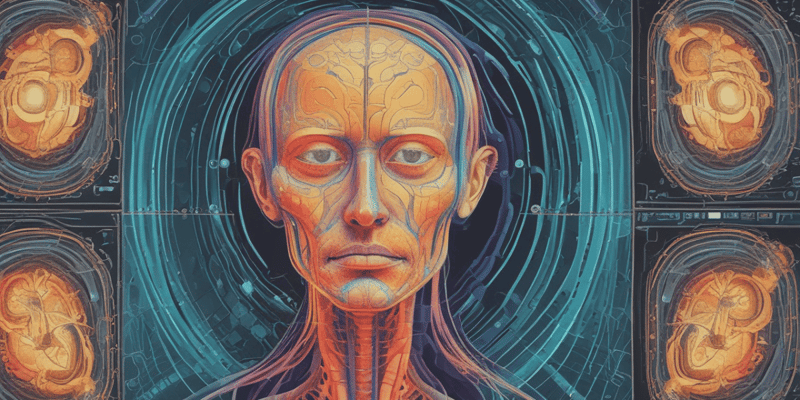Questions and Answers
What is the primary function of the magnet in an MRI machine?
Which of the following is an advantage of MRI over other imaging techniques?
Which application is NOT typically associated with MRI?
What type of contrast characteristics are produced by MRI?
Signup and view all the answers
What are gradient coils used for in MRI?
Signup and view all the answers
Which of the following is a limitation of MRI?
Signup and view all the answers
Which of the following should patients do before an MRI scan?
Signup and view all the answers
What role does the computer system play in MRI?
Signup and view all the answers
Study Notes
MRI Image
-
Definition: Magnetic Resonance Imaging (MRI) is a non-invasive diagnostic imaging technique used to visualize internal structures of the body.
-
How it Works:
- Utilizes strong magnetic fields and radio waves to generate images.
- The magnetic field aligns hydrogen atoms in the body.
- Radio waves disrupt this alignment, producing signals that are detected and converted into images.
-
Components:
- Magnet: Essential for creating the magnetic field; usually a superconducting magnet.
- Gradient Coils: Alter the magnetic field, allowing for spatial encoding of the MRI signals.
- Radiofrequency Coils: Transmit radio waves and receive the signals emitted by the body.
- Computer System: Processes the signals into images.
-
Image Characteristics:
- T1 and T2 weighting: Different types of contrast based on the timing of signal readouts.
- High contrast resolution for soft tissues, useful for brain, muscle, and connective tissue imaging.
- Images can be produced in various planes (axial, sagittal, coronal).
-
Applications:
- Neurology: Imaging of brain tumors, strokes, and neurodegenerative diseases.
- Orthopedics: Assessment of joint injuries, cartilage, and ligaments.
- Oncology: Detection and monitoring of tumors.
- Cardiology: Evaluation of heart structures and function.
-
Advantages:
- No ionizing radiation, making it safer than X-rays and CT scans.
- Superior contrast between different soft tissues.
- Provides detailed images of complex anatomical structures.
-
Limitations:
- Time-consuming: Scans can take from 15 minutes to over an hour.
- Cost: Generally more expensive than other imaging modalities.
- Contraindications: Not suitable for patients with certain metal implants, pacemakers, or claustrophobia.
-
Preparation for Patients:
- Remove all metal objects before entering the MRI scanner.
- Inform the technician about any implants or medical conditions.
- Patients may be required to lie still and may receive headphones or earplugs due to noise during the scan.
-
After the Procedure:
- Patients can usually resume normal activities immediately.
- Results are typically analyzed by a radiologist and reported to the referring physician.
MRI Image Overview
- Magnetic Resonance Imaging (MRI) is a non-invasive technique visualizing internal body structures.
- It employs strong magnetic fields and radio waves to generate detailed images.
How MRI Works
- Hydrogen atoms in the body align with the magnetic field created by the MRI machine.
- Radio waves disrupt this alignment, producing signals that are transformed into images.
Key Components of MRI
- Magnet: A superconducting magnet is crucial for establishing the magnetic field.
- Gradient Coils: These coils modify the magnetic field for spatial signal encoding.
- Radiofrequency Coils: Responsible for transmitting radio waves and receiving emitted signals.
- Computer System: Processes the recorded signals into visual images.
Image Characteristics
- MRI images can have varying contrasts, primarily T1 and T2 weighting based on signal readout timing.
- High contrast resolution enables detailed imaging of soft tissues like the brain, muscles, and connective tissues.
- Images can be produced in multiple orientations: axial, sagittal, and coronal.
Applications of MRI
- Neurology: Useful for assessing brain tumors, strokes, and neurodegenerative diseases.
- Orthopedics: Effective in evaluating joint injuries, including cartilage and ligament health.
- Oncology: Aids in the detection and monitoring of tumors.
- Cardiology: Evaluates heart structures and their functionality.
Advantages of MRI
- Does not use ionizing radiation, making it safer compared to X-rays and CT scans.
- Provides superior contrast between various soft tissues.
- Capable of yielding detailed images of complex anatomical structures.
Limitations of MRI
- Scanning duration can range from 15 minutes to over an hour, making it time-consuming.
- MRI typically costs more than other imaging methods.
- Not suitable for individuals with certain metal implants, pacemakers, or severe claustrophobia.
Patient Preparation and Procedure
- Patients must remove all metal objects prior to the scan.
- Disclosure of any implants or medical conditions to the technician is necessary.
- Patients are encouraged to remain still during the process and may be provided with headphones or earplugs to mitigate noise.
Post-Procedure Information
- Most patients can return to normal activities immediately following the MRI.
- A radiologist analyzes the results, which are then reported to the referring physician.
Studying That Suits You
Use AI to generate personalized quizzes and flashcards to suit your learning preferences.
Description
Explore the fundamentals of Magnetic Resonance Imaging (MRI) and how it works. This quiz covers the components involved, image characteristics, and the technology behind generating images of internal structures in the body. Perfect for students and professionals in the medical field.




